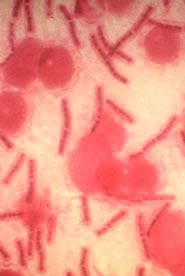Anthrax action shapes up

Anthrax is under close scrutiny. <br>© AP/Fort Detrick, US Army <br>
Researchers find two new leads for anti-anthrax drugs.
As fears over bioterrorism attacks spiral, researchers are making progress towards better anthrax drugs – but these are unlikely to reach the drugstore soon.
Of ten confirmed anthrax cases in the United States by Monday, four have been of the severe, inhaled form against which antibiotics often fail. By the time drugs destroy the bacteria responsible, Bacillus anthracis, the organisms have released enough lethal toxin to kill immune cells in the blood, causing fatal blood poisoning.
Two new discoveries lay the groundwork for drugs that could disable the toxin and, along with antibiotics, save lives.
John Young, of the University of Wisconsin in Madison, and his colleagues have pinpointed the protein, on the surface of human cells, which the anthrax toxin latches onto1. In the lab a synthetic version of this ’receptor’ mops up the poison and protects cells. “It serves as a decoy,” Young explains.
Part of the toxin attaches to this receptor, punches a hole in the human cell membrane and injects another part, the ’lethal factor’, which destroys proteins in the cell. A second team, led by Robert Liddington of The Burnham Institute in La Jolla, California, have deduced the structure of this lethal factor2.
With a picture of how the toxin’s proteins attack cells, drug companies can search for chemicals that block their activity, the teams hope.
This promise is unlikely to be realized in time to help the current situation, Young and Liddington caution – most optimistic estimates are that improvements will be a year in the making. “We need to design drugs – not for this time round but for the next one,” says Liddington.
Alternative medicine
The current crisis gives the hunt for effective treatments new urgency. What we have is no longer “state-of-the-art”, says Richard Corlin, director of the American Medical Association in Chicago, Illinois. The latest work “will lead us to a better treatment”, he agrees.
Excessive use of an existing antibiotic, ciprofloxacin, could create its own medical problems, Corlin warns. The drug destroys healthy bacteria in the body, so may leave people open to infection from other pathogens.
Overuse of antibiotics and failure to complete the 60-day course virtually “guarantee the emergence of antibiotic resistant strains” of these pathogenic bacteria, he says, making such infections difficult to treat.
Bioterrorists could potentially engineer antibiotic-resistant anthrax. Manufacturing bacteria able to withstand toxin-targeted drugs would be “almost impossible”, says John Collier of Harvard Medical School, who contributed to both studies. It would require expert biochemical knowledge to alter specific protein shapes and interactions.
The anthrax vaccine is also problematic. Developed in the 1960s, it involves injecting a crude mix of the toxin’s protein components to stimulate resistance. Vaccination requires six shots and regular boosters. The vaccine is currently produced only in sufficient quantities for the US military.
Several groups are designing more effective versions using purified proteins, explains anthrax researcher Stephen Leppla of the National Institute of Dental and Craniofacial Reseach in Bethesda, Maryland. These are easily administered and produce long-lasting immunity. “Before too long, we’ll have it,” he predicts.
Ultimately, we need a whole new arsenal to fight anthrax, says Collier – a new antibiotic, a safe, efficient vaccine, and drugs against toxins. Realizing this goal requires further funding for research and fast-track approval of candidate drugs, he suggests.
Meanwhile most people agree that heightened awareness remains the best form of defence, catching early, cold-like symptoms in time for the disease to be treated. “The key thing is an appropriate degree of surveillance,” says Corbin.
Spore show
Anthrax spores, the persistent, dormant form of the bacterium, can cause infection through the skin and intestine, but inhalation is the most dangerous – around 90% of cases result in death.
Turning anthrax into an effective bioweapon is technically difficult – spores must be milled down into a very fine powder (less than 5 micrometres in diameter) for them to reach the depths of the lungs in sufficient quantities to cause infection. A dose of around 10,000 spores is thought to cause a lethal infection.
Spores sent in letters to media and political organizations in the United States had produced ten confirmed cases by the end of Monday, including one death. The deaths of two more postal workers have been linked to the disease. The source of the letters has not yet been found, and the United States is offering a $1-million reward for information leading to the identification of those responsible.
References
- Bradley, K.A., Mogridge, J., Mourez, M., Collier, R.J. & Young, J.A.T. Identification of the cellular receptor for the anthrax toxin. Nature, (2001).
- Panniter, A. et al. Crystal structure of the anthrax lethal factor. Nature, (2001).
Media Contact
All latest news from the category: Health and Medicine
This subject area encompasses research and studies in the field of human medicine.
Among the wide-ranging list of topics covered here are anesthesiology, anatomy, surgery, human genetics, hygiene and environmental medicine, internal medicine, neurology, pharmacology, physiology, urology and dental medicine.
Newest articles

First-of-its-kind study uses remote sensing to monitor plastic debris in rivers and lakes
Remote sensing creates a cost-effective solution to monitoring plastic pollution. A first-of-its-kind study from researchers at the University of Minnesota Twin Cities shows how remote sensing can help monitor and…

Laser-based artificial neuron mimics nerve cell functions at lightning speed
With a processing speed a billion times faster than nature, chip-based laser neuron could help advance AI tasks such as pattern recognition and sequence prediction. Researchers have developed a laser-based…

Optimising the processing of plastic waste
Just one look in the yellow bin reveals a colourful jumble of different types of plastic. However, the purer and more uniform plastic waste is, the easier it is to…



